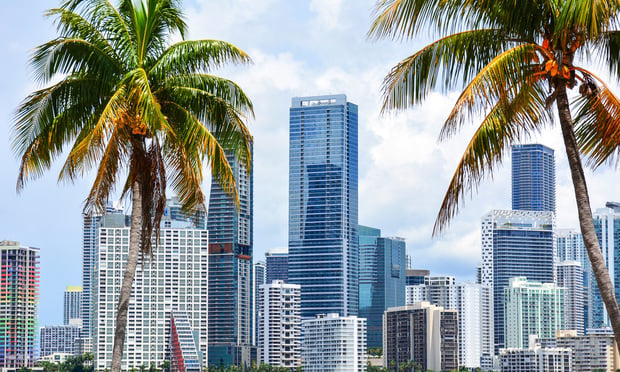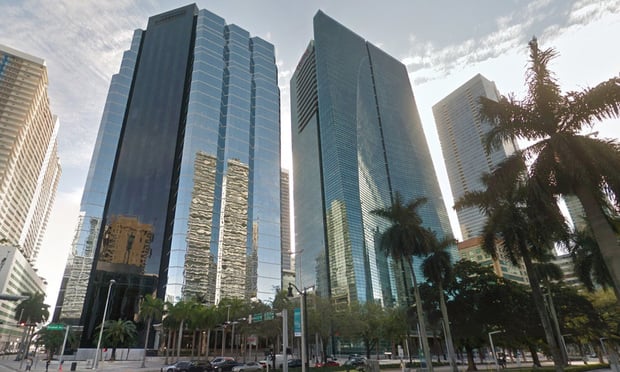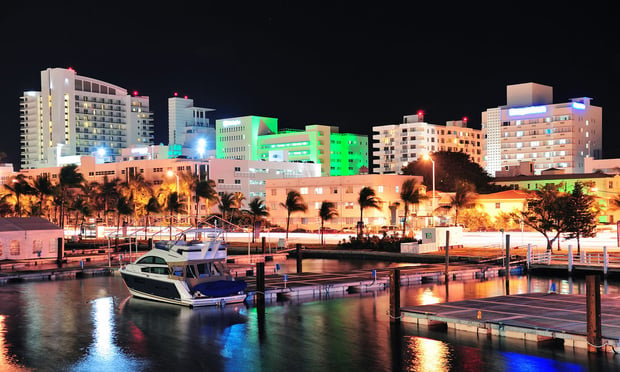(This story, in slightly different form, originally appeared in the Daily Business Review.)
Large holiday discounts weren't just limited to retailers hoping to move inventory off shelves in a recession year. Jim Clark, a Silicon Valley entrepreneur-turned-developer, apparently took the same approach to liquidate unsold condos at his MarinaBlue condo project at 888 Biscayne Blvd. in Downtown Miami. The Netscape co-founder has sold 60 units to an investment group at steep discounts. Singer Island-based Welcome Bay LLC paid about $13 million in the bulk deal.
Each unit had a different price, with some showing discounts of up to 70% compared to prices paid for similar units in March 2008 by individual buyers. For example, Welcome Bay bought Unit 2012 for $168,600, or $127.92 per square foot. The condo has 1,318 square feet of air conditioned space. In March, Unit 2112, an identical unit a floor above, sold for $557,740, or $423.17 per square foot, according to Miami-Dade County property records. The prices per square foot in the bulk sale ranged from about $126 to about$279.
Singer Island attorney Joseph Kuharcik, who represents Welcome Bay, declinedto comment on the transaction or to identify the individuals he represents. A representative of Clark's Hyperion Development declined to comment, but thecompany issued a written statement. "MarinaBlue has closed nearly $30 million in condominium sales over the past two months, placing all of its retail and office space as well as a block of residential units in the hands of owners with a long-term vision forMarinaBlue and Downtown Miami," the statement said.
The developer said closings in the project are expected to reach 90% soon, and the construction loan was "virtually paid off just nine months since closings began." Since the 516-condo high-rise opened in March, about 357 units have been sold, according to property records. With the bulk sale, the number of sold units jumped to 417, or about 80% of the building.
Several brokers say Hyperion likely was seeking to cut its carrying costs with the bulk sale. The developer is renting out some of the unsold condos, but at a rate of about $2 per square foot, the income is not enough to cover expenses, the brokers report.
Clark, who made his fortune before the dot-com bubble burst in 2000, is now dealing with the implosion of the residential real estate industry. He and former Silicon Valley executive Thomas Jermoluk planned the tower during the real estate boom, which peaked in mid-2005. The 57-story building overlooking Biscayne Bay wasn't finished until the housing market crashed, banks stopped making many mortgage loans and buyers began to disappear.
Now opportunity funds, also known as vulture funds, are circling condo projects stuck with blocks of unsold units. Investor Arnaud Karsenti, who leads an opportunity fund in Miami, says he looked at the MarinaBlue portfolio but decided to pass. He says the discounts for the 60 units weren't deep enough to justify his investment. "The problem with the Downtown/Brickell area is that real estate taxes and the maintenance costs alone are generally equal or higher than the rent payments," says Karsenti, a principal with 13th Floor Investments. "So most of your return will come from capital appreciation. And to make money you will need to buy it very cheap. Besides, it is very hard to basean analysis on capital appreciation at this time."
Although he passed on MarinaBlue, Karsenti and partner Robert Suris recentlybought 107 condos, townhouses and single-family homes in Homestead. The partners paid about $6.42 million on Nov. 11 for properties built in 2007 by Miami-based Caribe Homes, according to property records. About 70% of the units are currently tenant occupied. The residences are in four subdivisions in Keys Gate, a master-plannedcommunity built in sections by different developers.
Karsenti says he based the price he paid for the Homestead properties on what tenants could pay and what he expects potential buyers eventually will be able to afford. "We analyzed the demographics of the area, what people make, what people canpay for occupancy and then work backwards to understand what they can pay usfor rent or to buy a unit," he explains. "Then, of course, we looked to buybelow that value in order to make money."
Karsenti adds that some investors are looking at past sales or replacement costs todetermine current values. He doesn't. "Those are important metrics but not very relevant because, at the end of the day, the product is only worth what people can pay for," he says. "What people can pay for rent and how much they earn are the two maindrivers to determine the value of our acquisitions."
Karsenti's group paid $55,000 for two-bedroom condos that Caribe tried to sell for $186,990 in 2007. Karsenti also paid $70,000 for five-bedroom houses that were listed for about $300,000 more than a year ago. Those numbers are much lower than what he would have had to pay to acquire the MarinaBlue condos, he adds. "The rent there wouldn't cover the expenses," he says. "We are generally cash buyers and can hold out for longer. However, no one likes to write a check every month every year for a deal."
Karsenti, who expects a 15% to 25% return on his company's investments, reports that he is backed by Condo Capital Solutions, an investment firm in Colorado led by Marcel Arsenault. Karsenti, says he expects to hold the properties for about five years, and reveals that he is working on several other bulk deals but declined to give details.
Industry experts predict there will be a surge in bulk sales of condos in 2009. "It is going to be one of the major sources of business in Miami," says Jeff Morr, founder and chief executive officer of Majestic Properties in Miami. "Miami was the first market globally to fall, and I believe it will be the first market to rise. There are some fantastic deals out there. There are prices anywhere from 50% to 70% off what units sold for threeyears ago."
Morr says there are about 40 potential bulk-sale opportunities beingmarketed in South Florida. MarinaBlue was one of the buildings he showed toan investment group, but the numbers didn't make sense for his client. "For most investors, it is about rental income. Investors are not happy breaking even," he reports. They want to make a profit.
Paola Iuspa-Abbott can be reached at [email protected].
Want to continue reading?
Become a Free ALM Digital Reader.
Once you are an ALM Digital Member, you’ll receive:
- Breaking commercial real estate news and analysis, on-site and via our newsletters and custom alerts
- Educational webcasts, white papers, and ebooks from industry thought leaders
- Critical coverage of the property casualty insurance and financial advisory markets on our other ALM sites, PropertyCasualty360 and ThinkAdvisor
Already have an account? Sign In Now
*May exclude premium content© 2024 ALM Global, LLC, All Rights Reserved. Request academic re-use from www.copyright.com. All other uses, submit a request to [email protected]. For more information visit Asset & Logo Licensing.








